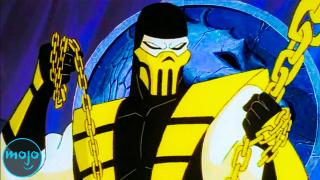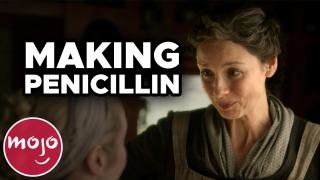Top 10 Differences Between Resident Evil: Infinite Darkness And The Video Games

#10: More Fleshed Out Storytelling
Top 10 WORST TV Shows Based on Video Games
With nine numbered installments (including Zero), and a plethora of spin-off titles—without counting the non-canon live-action movies—it’s easy to lose the plot a little. Compound that with the fact that there are two versions of the first three games set around Raccoon City, and it’s difficult to know where the canon lies. What makes all of that worse is the Pantomime-esque delivery of simplistic dialogue that plagued the early entries. With “Infinite Darkness” there are no “masters of unlocking,” or heart shaped keys. The plot is straightforward espionage, and the characters are nuanced in a way that doesn’t scream their intentions. In fact, some antagonists are understandable to a point.
#9: The Music Sounds Similar
Top 10 Biggest Differences Between the Castlevania Series and Video Games
Music is a big part of any video game, but for the Resident Evil series: it’s epic. Who can forget the spine-tingling melodies from the first game, or the calming safe-room from “Resident Evil 2?” For the 2019 remake of the latter, only one of the original composers (Shusaku Uchiyama) returned to scoring duties, bringing a new musical palette to the reimagined game. Still, the leitmotif of a descending piano, and the brassy, choral number of the boss battles were largely noticeable through their absence in the new game. Not wanting to sway too far from the source material, “Infinite Darkness” composer Yugo Kanno incorporates faint hints of both into the score, but still provides something that is completely different.
#8: President Graham
President Graham is never seen in “Resident Evil 4,'' save for one image of him, but his presence is felt throughout the whole game. He’s the one who took over the White House after the Government cleansed Raccoon City, and presided over the end of Umbrella. It is also his daughter Ashley whom you’re tasked with saving in the fourth game. The version that appears in the TV Show looks vastly different—and not as good as the other CGI characters. On the flip side, Ashley looks the exact same in the photos of her that we see. Hopefully, she’s had a personality transplant as well.
#7: Readily Available Weaponry
The “Resident Evil” franchise has always prided itself on being Survival Horror games. For the most part, weaponry is scarce and bullets are few and far between—and that’s on the normal setting. Despite what those hardcore gamers said, barely anyone rationed their ammo, or played with only the knife. It wouldn’t be until the last moments of the game that a halfway decent weapon would present itself, usually inside a weapons armory or thrown in by Deus Ex Machina Ada Wong, of course. Not in the TV Show, however. No, in this setting, characters simply open a nearby locker and pull out a bazooka. Seems the show is set on easy mode.
#6: Sadly No Scenario A or B
Something that the early “Resident Evil” games did so incredibly well (and kept going with the remakes) was the equal division of gameplay between the two main characters. There was no distinct advantage to playing as Chris over Jill, or as Claire over Leon, except a different—though equally as entertaining—story. The equal divide, for want of a better word, made for twice the game, and—particularly with the 2019 version of “Resident Evil 2”—more engaging characters. Unfortunately, despite having the same actors, the TV Show just doesn’t have that quality, reducing Claire to a supporting role. She’s still tough, just less seen. “Infinite Darkness” is really Leon’s story and Claire is only shoehorned in to serve that, unfortunately.
#5: Claire’s Appearance
Top 10 Times Claire Was a Badass on Outlander
Speaking of Claire, she’s a little different too between the last we saw her in 2019 and “Infinite Darkness”. The hallmark features are still there—the ponytail, the propensity for red jackets, the tough-girl attitude that made Chief Iron’s secretly cry. However, there seems to be a change in her facial appearance. Over the years, Claire was modelled on actresses Neve Campbell and Liv Tyler respectively. Most recently, her “Resident Evil 2” remake appearance is based on Canadian model Jordan Mcewen. For “Infinite Darkness”, that doesn’t appear to be the case. Plus, this version of her seems a little less energetic. Then again, maybe surviving zombies on multiple occasions has had a calming effect...
#4: Leon’s Voice… Sort of…
Bear with us… Leon's voice has technically changed a few times. Voice actor Paul Haddad portrayed him in 1998. For 2005's "Resident Evil 4" Paul Mercier took over. When the game was remade in 2019, disputes over the use of non-union actors meant that new voice actor Nick Apostolides assumed the duty of giving Leon S. Kennedy a voice, and this continues with “Infinite Darkness.” The difference is that since the setting of the show is between “Resident Evil 4” and 5, then technically shouldn’t Leon sound like Mercier? Guys? ...guys? Ok, it’s minor, but it does confuse things a little—if 2019 “RE2” is canon, is “RE4?” which used 1998 footage. And if so is “Code Veronica?”
#3: Faster & More Agile Zombies
They can climb fences, they can lunge, and they can even—well—fall through broken windows, but “Resident Evil: Infinite Darkness” may be the first time that the Zombies of this universe can actually run and jump. We aren’t counting the Crimson Head or Bomb Zombie’s from the Remake of “Resident Evil,” just the standard moaning, shuffling, mindless ones that we know, love and hate for falling over bannisters. And we like them because we mostly know where we are with them, since they’re slow. As players can we take a collective sigh that they don’t move at the speed the TV’s shows zombies do? Even the rats zip around and jump—which kinda explains how they escaped the underground Umbrella Lab after drinking from smashed G-Virus vials.
#2: Cleon, or Laire…
The relationship between Claire and Leon is very different to what we’re used to in “Infinite Darkness”. Remember, this show is set between “Resident Evils” 4 and 5 meaning that everything from the games that preceded it chronologically should be canon. That means that prior to this, the only time we have seen them interact since “RE2” was via a new fangled email in “Code Veronica,” three months afterwards. But here, they act very familiarly, and not in the “REmake” flirty way—but as constant contacts. Ok… but at the end of the series, they pretty much fall out. This calls all the subsequent games where Claire’s brother Chris and Leon partner up into question as well.
#1: The Penamstan Civil War
Top 20 Amazing Shows Based on Video Games
The events that kick off the story of “Resident Evil: Infinite Darkness” is the fictional Penamstan Civil War of 2000. On the timeline, this is 2 years post Raccoon City, and 6 years before the series picks up. This just about slides into canon, but only just. After bioweapons from a pharmaceutical company are leaked, causing an outbreak there, Penamstan is pretty much Raccoon City’d. Here’s the rub: the place has not been mentioned previously (or since) in-game. At this point Umbrella is quietly falling apart, leaving TRICELL (who didn’t show up until RE5) to later assume operations. Yet, it’s heavily implied in one of the final scenes that it was TRICELL all along, thus introducing them a lot earlier than the games did.





